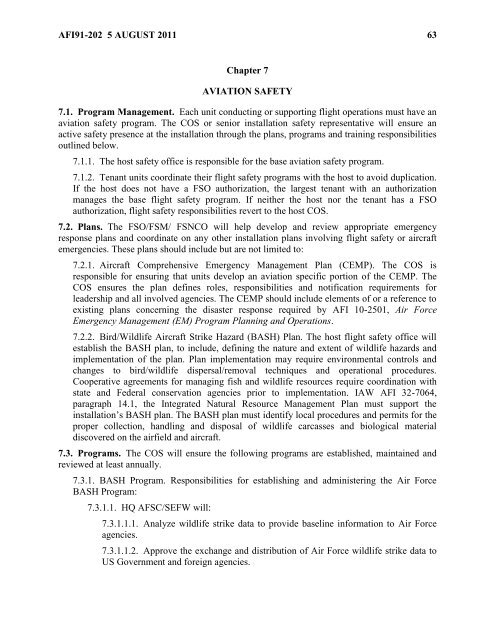MEMORANDUM FOR A1 - Air Force E-Publishing
MEMORANDUM FOR A1 - Air Force E-Publishing
MEMORANDUM FOR A1 - Air Force E-Publishing
Create successful ePaper yourself
Turn your PDF publications into a flip-book with our unique Google optimized e-Paper software.
AFI91-202 5 AUGUST 2011 63<br />
Chapter 7<br />
AVIATION SAFETY<br />
7.1. Program Management. Each unit conducting or supporting flight operations must have an<br />
aviation safety program. The COS or senior installation safety representative will ensure an<br />
active safety presence at the installation through the plans, programs and training responsibilities<br />
outlined below.<br />
7.1.1. The host safety office is responsible for the base aviation safety program.<br />
7.1.2. Tenant units coordinate their flight safety programs with the host to avoid duplication.<br />
If the host does not have a FSO authorization, the largest tenant with an authorization<br />
manages the base flight safety program. If neither the host nor the tenant has a FSO<br />
authorization, flight safety responsibilities revert to the host COS.<br />
7.2. Plans. The FSO/FSM/ FSNCO will help develop and review appropriate emergency<br />
response plans and coordinate on any other installation plans involving flight safety or aircraft<br />
emergencies. These plans should include but are not limited to:<br />
7.2.1. <strong>Air</strong>craft Comprehensive Emergency Management Plan (CEMP). The COS is<br />
responsible for ensuring that units develop an aviation specific portion of the CEMP. The<br />
COS ensures the plan defines roles, responsibilities and notification requirements for<br />
leadership and all involved agencies. The CEMP should include elements of or a reference to<br />
existing plans concerning the disaster response required by AFI 10-2501, <strong>Air</strong> <strong>Force</strong><br />
Emergency Management (EM) Program Planning and Operations.<br />
7.2.2. Bird/Wildlife <strong>Air</strong>craft Strike Hazard (BASH) Plan. The host flight safety office will<br />
establish the BASH plan, to include, defining the nature and extent of wildlife hazards and<br />
implementation of the plan. Plan implementation may require environmental controls and<br />
changes to bird/wildlife dispersal/removal techniques and operational procedures.<br />
Cooperative agreements for managing fish and wildlife resources require coordination with<br />
state and Federal conservation agencies prior to implementation. IAW AFI 32-7064,<br />
paragraph 14.1, the Integrated Natural Resource Management Plan must support the<br />
installation’s BASH plan. The BASH plan must identify local procedures and permits for the<br />
proper collection, handling and disposal of wildlife carcasses and biological material<br />
discovered on the airfield and aircraft.<br />
7.3. Programs. The COS will ensure the following programs are established, maintained and<br />
reviewed at least annually.<br />
7.3.1. BASH Program. Responsibilities for establishing and administering the <strong>Air</strong> <strong>Force</strong><br />
BASH Program:<br />
7.3.1.1. HQ AFSC/SEFW will:<br />
7.3.1.1.1. Analyze wildlife strike data to provide baseline information to <strong>Air</strong> <strong>Force</strong><br />
agencies.<br />
7.3.1.1.2. Approve the exchange and distribution of <strong>Air</strong> <strong>Force</strong> wildlife strike data to<br />
US Government and foreign agencies.
















